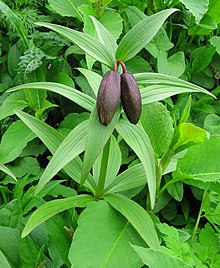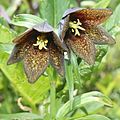
Lilium is a genus of herbaceous flowering plants growing from bulbs, all with large prominent flowers. They are the true lilies. Lilies are a group of flowering plants which are important in culture and literature in much of the world. Most species are native to the Northern Hemisphere and their range is temperate climates and extends into the subtropics. Many other plants have "lily" in their common names, but do not belong to the same genus and are therefore not true lilies.
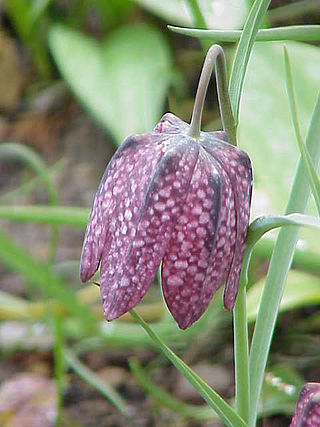
Fritillaria (fritillaries) is a genus of spring flowering herbaceous bulbous perennial plants in the lily family (Liliaceae). The type species, Fritillaria meleagris, was first described in Europe in 1571, while other species from the Middle East and Asia were also introduced to Europe at that time. The genus has about 130–140 species divided among eight subgenera. The flowers are usually solitary, nodding and bell-shaped with bulbs that have fleshy scales, resembling those of lilies. They are known for their large genome size and genetically are very closely related to lilies. They are native to the temperate regions of the Northern hemisphere, from the Mediterranean and North Africa through Eurasia and southwest Asia to western North America. Many are endangered due to enthusiastic picking.

Fritillaria meleagris is a Eurasian species of flowering plant in the lily family Liliaceae. Its common names include snake's head fritillary, snake's head, chess flower, frog-cup, guinea-hen flower, guinea flower, leper lily, Lazarus bell, chequered lily, chequered daffodil, drooping tulip or, in the British Isles, simply fritillary. The plant is a bulbous perennial native to the flood river plains of Europe where it grows in abundance.

Fritillaria affinis, the chocolate lily, is a highly variable species of flowering plant in the lily family Liliaceae native to western North America.
Chocolate lily refers to any of a number of flowering plant species:

Fritillaria pudica, the yellow fritillary, is a small perennial plant found in the sagebrush country in the western United States and Canada. It is a member of the lily family Liliaceae. Another common name is "yellow bells", since it has a bell-shaped yellow flower. It may be found in dryish, loose soil; it is amongst the first plants to flower after the snow melts, but the flower does not last very long; as the petals age, they turn a brick-red colour and begin to curl outward. The flowers grow singly or in pairs on the stems, and the floral parts grow in multiples of threes. The species produces a small corm, which forms corms earning the genus the nickname 'riceroot'. During his historic journey, Meriwether Lewis collected a specimen while passing through Idaho in 1806.

Fritillaria biflora, the chocolate lily or mission bells, is a species of fritillary native to western California, US, and northern Baja California, Mexico. It occurs in the chaparral and woodlands ecoregion, often in serpentine soil formations and hillside grassland habitats.

Streptopus amplexifolius is a species of flowering plant in the family Liliaceae, native to North America, Europe and Asia.

Fritillaria verticillata is a flowering plant in the lily family Liliaceae, native to Japan, Korea, Mongolia, Xinjiang, Kazakhstan and the Altay region of Siberia.
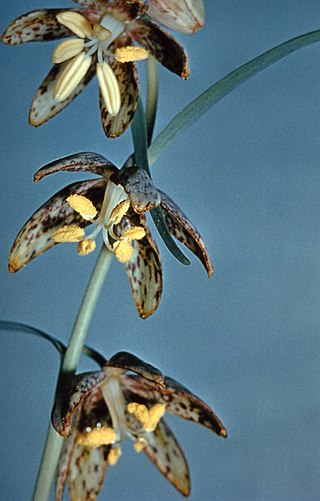
Fritillaria atropurpurea is a species of fritillary known by several common names, including spotted fritillary, purple fritillary, spotted mountainbells, spotted missionbells, and leopard lily.
Fritillaria micrantha, the brown fritillary or brown bells, is a Californian species of flowering plant in the lily family Liliaceae.

Fritillaria pluriflora is a rare California fritillary known as adobe lily. This wildflower is mainly limited to northern California. It grows in adobe clay soils of the Coast Ranges and low hills in the Central Valley from Tehama and Mendocino Counties south to Solano County.

Fritillaria striata, the striped adobe lily, is an uncommon species of fritillary.

Fritillaria purdyi, the Purdy's fritillary, is a rare species of flowering plant in the lily family Liliaceae.
Fritillaria viridea is a rare species of flowering plant in the lily family Liliaceae, known by the common name San Benito fritillary. It is endemic to the Central Coast Ranges of California, USA, where it belongs to the chaparral and serpentine soils flora. There are confirmed records of this species from San Benito and Monterey Counties plus unconfirmed reports from Fresno and San Luis Obispo Counties.
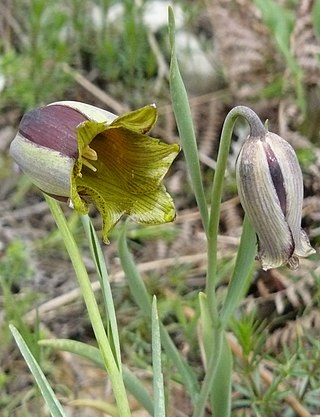
Fritillaria acmopetala, the pointed-petal fritillary, is a species of flowering plant in the lily family Liliaceae, native to rocky limestone mountain slopes in the Middle East. It was described by the Swiss botanist Pierre Edmond Boissier in 1846.
Fritillaria cirrhosa, common name yellow Himalayan fritillary, is an Asian species of herbaceous plant in the lily family, native to China, the Indian Subcontinent, and Myanmar.
Fritillaria chitralensis is a species of flowering plant in the lily family Liliaceae, native to Afghanistan and the Chitral District of northern Pakistan.
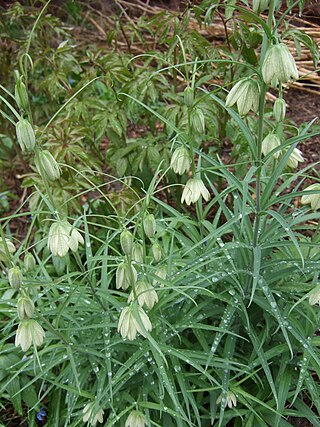
Fritillaria thunbergii is a flowering plant species in the lily family Liliaceae. It is native to Kazakhstan and in Xinjiang Province of western China, though cultivated in other places and naturalized in Japan and in other parts of China.
